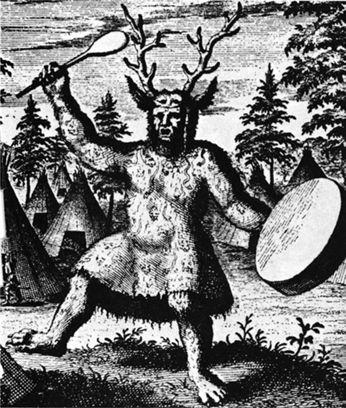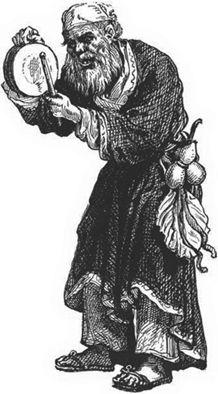The Sorcerer's Companion: A Guide to the Magical World of Harry Potter (47 page)
Read The Sorcerer's Companion: A Guide to the Magical World of Harry Potter Online
Authors: Allan Zola Kronzek,Elizabeth Kronzek
During the Middle Ages, the most famous magicians of legend were found in wondrous tales of the adventures of gallant knights, virtuous maidens, and noble kings.
Merlin
, advisor to King Arthur, was the most famous of all, known for his power to turn night into day, produce phantom armies, foretell the future, and assume a variety of human and animal forms. Readers of
Orlando Furioso
, an epic Italian adventure written in 1516, knew a different set of magicians,
sorcerers
, and enchantresses, who seemed to be engaged in a never-ending battle to out-magic each other. In one episode, the wizard Atlante casts a spell on the knight Astolfo (rider of the famed
hippogriff
), causing him to appear as a beast, a
giant
, and a bird all at once, depending on who’s looking at him. Later in the story, the enchantress Melissa transforms herself into the likeness of Atlante in order to rescue the hero of the story, Rogero, who has been enchanted by yet another wizard!
Today’s readers, of course, are entranced by a new cast of legendary magicians whose powers are no less wondrous than those of the sorcerers of old. Like all great magicians, these modern wizards have the power to transform and enchant not only one another, but us as well. During the school year, they can all be found at the same address—Hogwarts School of Witchcraft and Wizardry.

The oldest type of historical magician is the tribal sorcerer, also known as a medicine man or shaman. Shamans were the first doctors, priests, and specialists in the supernatural. Their practices date back at least 30,000 years and still survive in some cultures today. In many tribal societies, the shaman occupied a position of power and prestige that was second only to that of the chief. His or her weighty responsibilities included healing and
divination
; communication with the spirit world; ensuring the food supply through hunting, fishing, and fertility magic; finding lost objects and missing persons; locating and identifying thieves; and protecting the village and thwarting its enemies. Shamans made
amulets
and
talismans
, performed rituals and cast
spells
, and understood the medicinal properties of herbs, plants, and minerals. They were also the keepers of the tribe’s lore, traditions, and mythology.
In some cultures the shaman inherited his position; in others he was appointed by his predecessor. Sometimes a shaman was an apparently ordinary person who received a “calling” to the job through a
dream
, vision, or other unusual extraordinary experience. He would then retreat to the wilderness and live alone like a wild animal, perhaps for weeks or months, as he learned to control his gifts. Often he would fast for long periods. If all went according to tradition, he would have a dream or vision in which he received instruction from a guardian animal spirit about his future, his powers, and his role in the community. He would then return to society and begin his new life.

Although shamanism can be found in many parts of the world, it was originally associated with Siberian and Eskimo cultures. This eighteenth-century engraving depicts a shaman of the Tungus people of Siberia
. (
photo credit 50.1
)
Most of the shaman’s powers were said to come from the invisible realm of ancestor and animal spirits, which he contacted by entering a trance. Shamanistic ceremonies were part of tribal life, and involved community chanting, dancing, and drumming during which the shaman usually danced himself into a frenzy and was thought to leave his body, communicate with his spirit guides, and return with valuable information. Depending upon the culture, a shaman might wear ceremonial animal skins, put on a mask or a set of antlers, paint his face and body, or drape himself in a feathered cloak symbolizing his “flight” to the other world.
In many cultures, shamanic rituals were accompanied by displays of supernatural power that were actually accomplished by trickery. Using sleight of hand and other secret techniques, tribal magicians could apparently stab themselves without injury, walk on fire, escape from ropes, swallow knives, eat glass, and cause small dolls to dance. Using ventriloquism, they sometimes held public conversations with invisible spirits. These demonstrations must have had a profound impact on those who saw them and contributed to the psychological effectiveness of shamanistic medicine.
Interestingly, the use of trickery did not necessarily mean that the shaman’s abilities to heal the sick were fraudulent. Most shamans believed in their powers, and so did the community at large. That’s one of the things that made them effective. It never hurt to be able to display one’s mastery of the supernatural, however, especially during important ceremonies.

From medieval times until well into the nineteenth century, nearly every European town and village had a resident magician whose role was similar to that of the tribal shaman. Known variously as a wizard, a wise woman, or a “cunning” man or woman (from the Old English root
cunnan
, meaning, “to know”), the village magician was consulted for healing and divination and all the other things for which ancient people had turned to the shaman. Unlike shamans, however, cunning men and wise women conducted their business privately, rather than in the public ceremonies typical of tribal magic, and although they sometimes dressed more eccentrically than their fellow citizens, they didn’t wear animal skins, perform ritual dances, or enter trances. But many of their practices were the same: They were knowledgeable about herbal medicine, used healing
charms
, and made talismans, amulets, and love potions. In smaller villages, cunning men and women served as doctors and even veterinarians. Some cunning men and women knew the basics of
astrology
and
palmistry
(subjects unknown to earlier tribal cultures), as well as dream interpretation, which they learned from popular booklets. But many cunning men and women were illiterate, and their knowledge of folk remedies and potions came from fellow practitioners or from friends and relatives. Some legends said that village magicians learned their secrets from
fairies
.

Village cunning men often dressed and acted strangely, but they knew things that ordinary people didn’t
. (
photo credit 50.2
)
Although there were laws against practicing magic, most cunning men and wise women operated openly. The services they provided were in great demand and as long as they did no harm they were left alone by authorities. Many were regarded as “oddball” types who kept to themselves and lived on the outskirts of town where they maintained herbal gardens for their remedies. Their homes were rumored to be filled with strange items, such as
magic mirrors, crystal balls
, or other devices associated with divination. Cunning men and women were respected, feared, and often avoided. But most everyone knew where to find one when they needed to.
Cunning men also had practices in the larger European cities. Operating on a more sophisticated level than their country cousins, urban cunning folk charged higher fees and were often consulted by wealthy aristocrats. One of the best-known cunning men of his time was the London practitioner Simon Forman, who lived from 1552 to 1611. Unlike most of his peers, who feared leaving written evidence of their sometimes illegal activities, Forman kept detailed journals which reveal the types of matters on which he was consulted. Merchants wanted astrological advice about business matters; sailors’ wives inquired about their husbands’ safety; distraught patrons sought information about missing pets or stolen property; people wanted spells cast and spells removed; and many came to buy love potions, talismans, amulets, and herbal medicines. Forman was an astrologer and crystal-ball gazer, but he also considered himself a qualified doctor. Although he had no official medical training, he apparently produced many successful cures at a time when the accepted medicine of the day involved bloodletting and other therapies that are now known to be more harmful than helpful. Despite the opposition of the Royal College of Physicians, Forman was awarded a medical license from Cambridge University in 1603 and went on to become physician to many of Elizabethan London’s wealthiest citizens.
According to popular lore, Forman cast a
horoscope
in which he predicted the exact hour of his own death, which took place on September 8, 1611, while he was rowing on the Thames River. He left behind an estate worth £1,200, a considerable fortune for a man of his time.

“Nowadays,” wrote an Englishman in the year 1600, “[a man] is not adjudged any scholar at all, unless he can tell men’s horoscopes, cast out devils, or hath some skill in soothsaying.”
The idea that a learned man might occupy himself with these traditional magician’s arts would have been unthinkable little more than a hundred years earlier. But during the late fifteenth and sixteenth centuries, magic had gained a new intellectual respectability. In Renaissance Italy, scholars had revived the ancient notion that magic could serve as a way of achieving spiritual goals and mastery over the natural world. Through diligent study, self-knowledge, and the power of imagination, he could learn to use magic words, incantations, and symbols to control the hidden forces of nature and achieve virtually anything.